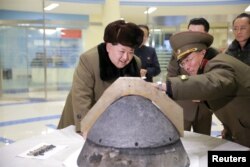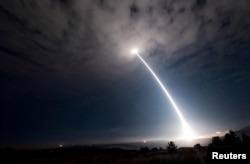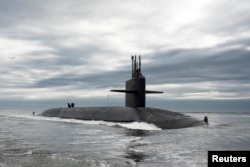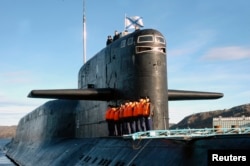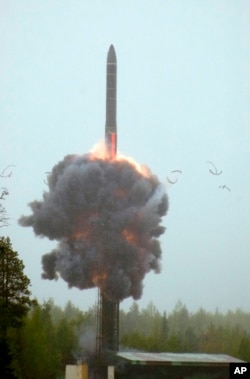The editor-in-chief of the Russian magazine National Defense, Igor Korotchenko calls “sheer lunacy” provisions if the new, draft United States Nuclear Posture Review (NPR). The doctrine outlines the role of nuclear weapons in U.S. security policy and military strategy.
The Huffington Post obtained and published a leaked unclassified version of the draft on January 12. According to the NPR, the U.S. seeks to modernize its aging nuclear arsenal. It also proposes the U.S. develop low-yield tactical nuclear warheads for submarine-launched missiles and new submarine-launched nuclear-capable cruise missiles to provide for a more effective extended nuclear deterrence in order to protect itself and its allies in Europe and Asia.
In a major departure from the previous NPR, which the administration of former U.S. President Barack Obama adopted in 2010, the new NPR contemplates the U.S. using nuclear weapons in response to both nuclear and significant conventional attacks on the population centers, infrastructure, and military command and control centers of the U.S. and its allies.
The document, expected to be finalized in February, has triggered debate among experts and advocates in the U.S. and beyond. That includes Russia, where critics argue that the new doctrine is not justified given the prevailing threat environment, and that it would undermine strategic stability by triggering an arms race. RT has even alarmingly reported that the United States is now “readying for a war with Russia in eastern Europe using nuclear weapons.”
But while the NPR’s assessment is debatable, it points to a series of military, technological, and geopolitical trends that arguably rationalize the need for the United States to bolster its extended deterrence capabilities to protect itself and its allies.
The fear expressed in Russia and among arms control advocates is that, under the new NPR, the U.S. would interpret loosely the circumstances under which its nuclear weapons could be used. According to Frants Klintsevich, first deputy chairman of the defense and security committee of the Federation Council, the upper chamber of Russia’s parliament, the doctrine gives Washington “cart blanche for the use of nuclear weapons.” Kingston Reif of the Arms Control Association, in turn, argues that the language in the NPR is “dangerously permissive.”
The founder of a global organization for elimination of nuclear weapons also raises an alarm over the NPR. Bruce Blair of Global Zero, also a research scholar at Princeton University, says the NPR “declares a newfound readiness to use U.S. nuclear weapons first and early in a confrontation with Russia and possibly others…an ill-conceived stroke.”
However, the authors of the NPR emphasize that “the use of nuclear weapons is contemplated only in the most extreme circumstances” to protect U.S., allied, and partner “vital interests.”
Russia’s doctrine similarly relies on its nuclear weapons to retaliate against both nuclear and significant conventional attacks if they put “the very existence of the state” in jeopardy.
Experts are also concerned about the idea of and need to develop low-yield nuclear weapons.
According to the NPR, these weapons would provide “additional diversity in platforms, range, and survivability, and a valuable hedge against future nuclear ‘break out’ scenarios.” Their development would putatively make more credible an extended nuclear and conventional deterrence in Eastern Europe, where the balance of forces currently favors Russia. The fact that the United States has retired or dismantled almost all of its tactical nuclear warheads, while Russia has been pushing ahead with their development, reinforces this imperative, the NPR says.
Washington is especially concerned that in a hypothetical scenario, Moscow could use tactical nuclear weapons in Eastern Europe as part of an “escalate-to-de-escalate” approach while believing that the United States would not use strategic nuclear weapons in retaliation. NPR notes that the new strategy seeks to deny Russia any perceived advantages of using non-nuclear or nuclear escalation options.
Yet, some experts question whether low-yield tactical nuclear weapons could be sensibly used. Jeffrey Lewis, director of the non-proliferation program at the James Martin Center for Nonproliferation Studies, believes that using low-yield nuclear weapons in a way that controls the escalation of conflict, is a bad idea since it risks triggering an all-out nuclear war.
And the head of the Russia-based Strategic Conjecture Center, Ivan Konovalov, says the low-yield nuclear weapons actually reduce the nuclear threshold because they create the illusion that their limited use “would not produce serious consequences.” The U.S. plans to develop a global anti-missile defense shield only adds to this illusion, claims Victor Murakhovsky, editor of the Russia-based magazine Arsenal of the Motherland. Moreover, such weapons arguably weaken deterrence because they presuppose their use of without triggering an all-out nuclear war that leads to mutually assured destruction.
The NPR, in contrast, maintains that the doctrine increases the threshold for using nuclear weapons because it convinces adversaries that “even limited use of nuclear weapons will be more costly than they can countenance.”
Neither Konovalov nor Murakhovsky raise concerns about Russia’s own low-yield nuclear warheads or deflect concerns about the arguably lower bar for Russia to use nuclear weapons.
Finally, some experts believe the United States already has sufficient deterrent capabilities, and increasing them, as the NPR advocates, would only prompt an arms race. Alexandra Bell, senior policy director at the Center for Arms Control and Non-Proliferation, says the U.S. arsenal of 4,000 nuclear weapons is more than sufficient. According to Hans Kristensen, who leads the Nuclear Information Project at the Federation of American Scientists, the U.S. nuclear forces already have sufficient flexibility: “The United States already has flexible nuclear forces, advanced conventional capabilities, tailored war plans and low-yield warheads in its arsenal.”
This contrasts with the NPR’s and independent assessments that the nuclear and missile programs of Russia, China, and North Korea are increasingly sophisticated and menacing, and that this, along with the alleged violations of international treaties by Moscow and Pyongyang, is forcing the United States to upgrade its nuclear arsenal and ensure that it has diverse options to respond to a range of evolving threats.
While experts continue to disagree on the risks and benefits of the doctrine, even domestic skeptics point out much of the review is a restatement of previous nuclear policies. None use Korotchenko’s term, “lunacy,” or say that the U.S. intends to launch a nuclear attack. The final version is expected in February when there could be changes.







